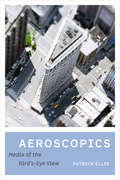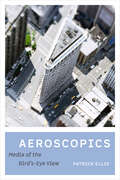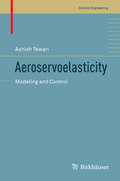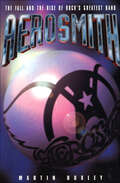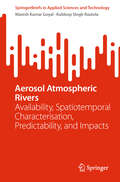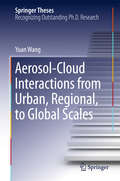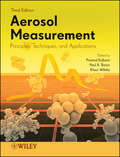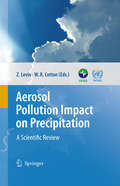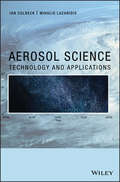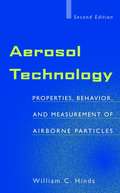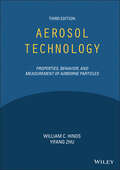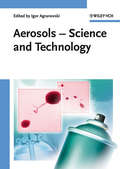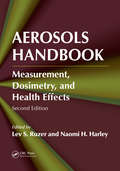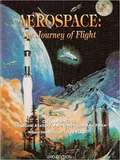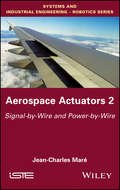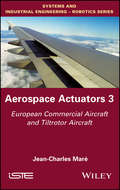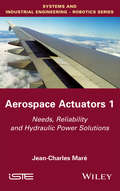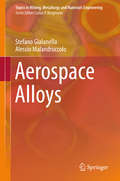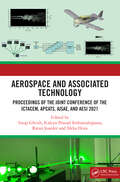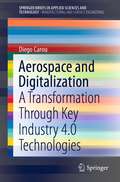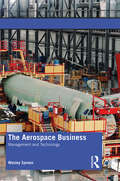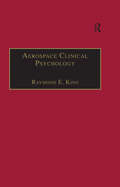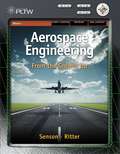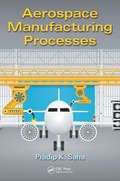- Table View
- List View
Aeroscopics: Media of the Bird's-Eye View
by Patrick EllisIn 1900, Paris had no skyscrapers, no tourist helicopters, no drones. Yet well before aviation made aerial views more accessible, those who sought such vantages had countless options available to them. They could take in the vista from an observation ride, see a painting of the view from Notre-Dame, or overlook a miniature model city. In Aeroscopics, Patrick Ellis offers a history of the view from above, written from below. Richly illustrated and premised upon extensive archival work, this interdisciplinary study reveals the forgotten media available to the public in the Balloon Era and after. Ellis resurrects these neglected spectacles as "aeroscopics," opening up new possibilities for the history of aerial vision.
Aeroscopics: Media of the Bird's-Eye View
by Patrick EllisIn 1900, Paris had no skyscrapers, no tourist helicopters, no drones. Yet well before aviation made aerial views more accessible, those who sought such vantages had countless options available to them. They could take in the vista from an observation ride, see a painting of the view from Notre-Dame, or overlook a miniature model city. In Aeroscopics, Patrick Ellis offers a history of the view from above, written from below. Richly illustrated and premised upon extensive archival work, this interdisciplinary study reveals the forgotten media available to the public in the Balloon Era and after. Ellis resurrects these neglected spectacles as "aeroscopics," opening up new possibilities for the history of aerial vision.
Aeroservoelasticity: Modeling and Control (Control Engineering)
by Ashish TewariThis monograph presents the state of the art in aeroservoelastic (ASE) modeling and analysis and develops a systematic theoretical and computational framework for use by researchers and practicing engineers. It is the first book to focus on the mathematical modeling of structural dynamics, unsteady aerodynamics, and control systems to evolve a generic procedure to be applied for ASE synthesis. Existing robust, nonlinear, and adaptive control methodology is applied and extended to some interesting ASE problems, such as transonic flutter and buffet, post-stall buffet and maneuvers, and flapping flexible wing. The author derives a general aeroservoelastic plant via the finite-element structural dynamic model, unsteady aerodynamic models for various regimes in the frequency domain, and the associated state-space model by rational function approximations. For more advanced models, the full-potential, Euler, and Navier-Stokes methods for treating transonic and separated flows are also briefly addressed. Essential ASE controller design and analysis techniques are introduced to the reader, and an introduction to robust control-law design methods of LQG/LTR and H2/H∞ synthesis is followed by a brief coverage of nonlinear control techniques of describing functions and Lyapunov functions. Practical and realistic aeroservoelastic application examples derived from actual experiments are included throughout. Aeroservoelasiticity fills an important gap in the aerospace engineering literature and will be a valuable guide for graduate students and advanced researchers in aerospace engineering, as well as professional engineers, technicians, and test pilots in the aircraft industry and laboratories.
Aerosmith: The Fall and the Rise of Rock's Greatest Band
by Martin HuxleyIn Aerosmith, Martin Huxley chronicles the fall and the rise of rock's greatest band. Read about the origins of mega rockstars Steven Tyler, Joe Perry, Tom Hamilton, Brad Whitford, and Joey Kramer--from the group's near break-up to their path of success that would eventually lead to them to Rock and Roll Hall of Fame.
Aerosol Atmospheric Rivers: Availability, Spatiotemporal Characterisation, Predictability, and Impacts (SpringerBriefs in Applied Sciences and Technology)
by Manish Kumar Goyal Kuldeep Singh RautelaThis book thoroughly examines aerosol pollution and aerosol atmospheric rivers (narrow corridors of concentrated suspended aerosols in the sky), exploring their significant effects on human health, the environment, and global climate. Readers will find detailed discussions on these phenomena' sources, composition, patterns, and advanced methods for their detection, monitoring, and mitigation. Each chapter examines the complex dynamics of aerosol atmospheric rivers and the use of data mining and artificial intelligence in analyzing aerosol pollution. The book also highlights the interactions between aerosol pollution, aerosol atmospheric rivers, and particulate matter concentrations with associated risk, offering practical adaptation, mitigation, and resilience strategies.
Aerosol-Cloud Interactions from Urban, Regional, to Global Scales (Springer Theses)
by Yuan WangThe studies in this dissertation aim at advancing our scientific understandings about physical processes involved in the aerosol-cloud-precipitation interaction and quantitatively assessing the impacts of aerosols on the cloud systems with diverse scales over the globe on the basis of the observational data analysis and various modeling studies. As recognized in the Fifth Assessment Report by the Inter-government Panel on Climate Change, the magnitude of radiative forcing by atmospheric aerosols is highly uncertain, representing the largest uncertainty in projections of future climate by anthropogenic activities. By using a newly implemented cloud microphysical scheme in the cloud-resolving model, the thesis assesses aerosol-cloud interaction for distinct weather systems, ranging from individual cumulus to mesoscale convective systems. This thesis also introduces a novel hierarchical modeling approach that solves a long outstanding mismatch between simulations by regional weather models and global climate models in the climate modeling community. More importantly, the thesis provides key scientific solutions to several challenging questions in climate science, including the global impacts of the Asian pollution. As scientists wrestle with the complexities of climate change in response to varied anthropogenic forcing, perhaps no problem is more challenging than the understanding of the impacts of atmospheric aerosols from air pollution on clouds and the global circulation.
Aerosol Measurement
by Klaus Willeke Paul A. Baron Pramod KulkarniAerosol Measurement: Principles, Techniques, and Applications Third Edition is the most detailed treatment available of the latest aerosol measurement methods. Drawing on the know-how of numerous expert contributors; it provides a solid grasp of measurement fundamentals and practices a wide variety of aerosol applications.This new edition is updated to address new and developing applications of aerosol measurement, including applications in environmental health, atmospheric science, climate change, air pollution, public health, nanotechnology, particle and powder technology, pharmaceutical research and development, clean room technology (integrated circuit manufacture), and nuclear waste management.
Aerosol Optical Depth and Precipitation: Measuring Particle Concentration, Health Risks and Environmental Impacts
by Sneha Gautam Cyril Samuel Roshini Praveen KumarThis volume uses aerosol optical depth (AOD) analysis through mapping and remote sensing techniques to derive the relationship between aerosols and hazardous precipitation events, primarily in the form of flooding. Attention is also given to pollution caused by an abundance of particulate matter in the atmosphere and its impacts on human health, which is also assessed via the study of AOD. Background is given on how AOD is retrieved, and why it is a useful tool for estimating atmospheric particle concentration, but also the challenges associated with using this approach. Different aerosol types are introduced to perform a comparative analysis of the most common associations between pollution impacts on temperature and resulting precipitation events. These analyses will help to provide an overview of the best strategies to make informed and sustainable disaster risk management practices and policies. The target audience for the work is students, researchers, and scientists working witha vision towards sustainability, public health safety and air pollution mitigation measures. It will also be a useful text for climate change policy makers, environmental engineers and stakeholders in social development sectors.
Aerosol Pollution Impact on Precipitation: A Scientific Review
by Zev Levin William R. CottonLife on Earth is critically dependent upon the continuous cycling of water between oceans, continents and the atmosphere. Precipitation (including rain, snow, and hail) is the primary mechanism for transporting water from the atmosphere back to the Earth's surface. It is also the key physical process that links aspects of climate, weather, and the global hydrological cycle. Changes in precipitation regimes and the frequency of extreme weather events, such as floods, droughts, severe ice/snow storms, monsoon fluctuations and hurricanes are of great potential importance to life on the planet. One of the factors that could contribute to precipitation modification is aerosol pollution from various sources such as urban air pollution and biomass burning. Natural and anthropogenic changes in atmospheric aerosols might have important implications for precipitation by influencing the hydrological cycle, which in turn could feed back to climate changes. From an Earth Science perspective, a key question is how changes expected in climate will translate into changes in the hydrological cycle, and what trends may be expected in the future. We require a much better understanding and hence predictive capability of the moisture and energy storages and exchanges among the Earth's atmosphere, oceans, continents and biological systems. This book is a review of our knowledge of the relationship between aerosols and precipitation reaching the Earth's surface and it includes a list of recommendations that could help to advance our knowledge in this area.
Aerosol Science
by Ian Colbeck LazaridisAerosols influence many areas of our daily life. They are at the core ofenvironmental problems such as global warming, photochemical smog andpoor air quality. They can also have diverse effects on human health, whereexposure occurs in both outdoor and indoor environments.However, aerosols can have beneficial effects too; the delivery of drugs to thelungs, the delivery of fuels for combustion and the production of nanomaterialsall rely on aerosols. Advances in particle measurement technologies havemade it possible to take advantage of rapid changes in both particle size andconcentration. Likewise, aerosols can now be produced in a controlled fashion.Reviewing many technological applications together with the current scientificstatus of aerosol modelling and measurements, this book includes:* Satellite aerosol remote sensing* The effects of aerosols on climate change* Air pollution and health* Pharmaceutical aerosols and pulmonary drug delivery* Bioaerosols and hospital infections* Particle emissions from vehicles* The safety of emerging nanomaterials* Radioactive aerosols: tracers of atmospheric processesWith the importance of this topic brought to the public's attention after theeruption of the Icelandic volcano Eyjafjallajökull, this book provides a timely,concise and accessible overview of the many facets of aerosol science.
Aerosol Technology
by William C. HindsThe #1 guide to aerosol science and technology -now better than everSince 1982, Aerosol Technology has been the text of choice among students and professionals who need to acquire a thorough working knowledge of modern aerosol theory and applications. Now revised to reflect the considerable advances that have been made over the past seventeen years across a broad spectrum of aerosol-related application areas - from occupational hygiene and biomedical technology to microelectronics and pollution control -this new edition includes:* A chapter on bioaerosols* New sections on resuspension, transport losses, respiratory deposition models, and fractal characterization of particles* Expanded coverage of atmospheric aerosols, including background aerosols and urban aerosols* A section on the impact of aerosols on global warming and ozone depletion.Aerosol Technology, Second Edition also features dozens of new, fully worked examples drawn from a wide range of industrial and research settings, plus new chapter-end practice problems to help readers master the material quickly.
Aerosol Technology: Properties, Behavior, and Measurement of Airborne Particles
by William C. Hinds Yifang ZhuAEROSOL TECHNOLOGY An in-depth and accessible treatment of aerosol theory and its applications The Third Edition of Aerosol Technology: Properties, Behavior, and Measurement of Airborne Particles delivers a thorough and authoritative exploration of modern aerosol theory and its applications. The book offers readers a working knowledge of the topic that reflects the numerous advances that have been made across a broad spectrum of aerosol-related application areas. New updates to the popular text include treatments of nanoparticles, the health effects of atmospheric aerosols, remote sensing, bioaerosols, and low-cost sensors. Additionally, readers will benefit from insightful new discussions of modern instruments. The authors maintain a strong focus on the fundamentals of the discipline, while providing a robust overview of real-world applications of aerosol theory. New exercise problems and examples populate the book, which also includes: Thorough introductions to aerosol technology, key definitions, particle size, shape, density, and concentration, as well as the properties of gases Comprehensive explorations of uniform particle motion, particle size statistics, and straight-line acceleration and curvilinear particle motion Practical discussions of particle adhesion, Brownian motion and diffusion, thermal and radiometric forces, and filtration In-depth examinations of sampling and measurement of concentration, respiratory deposition, coagulation, condensation, evaporation, and atmospheric aerosols Perfect for senior undergraduate and junior graduate students of science and technology, Aerosol Technology: Properties, Behavior, and Measurement of Airborne Particles will also earn a place in the libraries of professionals working in industrial hygiene, air pollution control, climate science, radiation protection, and environmental science.
Aerosols: Science and Technology
by Igor AgranovskiThis self-contained handbook and ready reference examines aerosol science and technology in depth, providing a detailed insight into this progressive field. As such, it covers fundamental concepts, experimental methods, and a wide variety of applications, ranging from aerosol filtration to biological aerosols, and from the synthesis of carbon nanotubes to aerosol reactors. Written by a host of internationally renowned experts in the field, this is an essential resource for chemists and engineers in the chemical and materials disciplines across multiple industries, as well as ideal supplementary reading in graduate level courses.
Aerosols Handbook: Measurement, Dosimetry, and Health Effects, Second Edition
by Lev S. Ruzer Naomi H. HarleyWith the rapid growth of the nanotechnology industry, the need to understand the biological effects of aerosol exposure has become increasingly important. Featuring contributions by leading experts in the field, Aerosols Handbook: Measurement, Dosimetry, and Health Effects, Second Edition offers an up-to-date overview of many aspects of aerosols, f
Aerospace: The Journey of Flight (Second Edition)
by Jeff MontgomeryA tremendous amount of cooperation and teamwork accompanied the production of this book, and we are extremely grateful to the many dedicated people and organizations who contributed their time, talents, and resources.
Aerospace Actuators: Signal-by-Wire and Power-by-Wire
by Jean-Charles MaréThis book is the second in a series of volumes that cover the topic of aerospace actuators following a systems-based approach.This second volume brings an original, functional and architectural vision to electric aerospace actuators. The aspects of signal (Signal-by-Wire) and power (Power-by-Wire) are treated from the point of view of necessity, their evolution throughout history, and operational solutions both existing and in development. This volume is based on an extensive bibliography, numerous supporting examples and orders of magnitude which refer to flight commands and landing gear for various aircraft (planes, helicopters and missile launchers) in commercial, private and military applications. The topics covered in this set of books constitute a significant source of information for individuals and engineers from a variety of disciplines, seeking to learn more about aerospace hydraulics.
Aerospace Actuators
by Jean-Charles MaréThis book is the third in a series dedicated to aerospace actuators. It uses the contributions of the first two volumes to conduct case studies on actuation for flight controls, landing gear and engines. The actuation systems are seen in several aspects: signal and power architectures, generation and distribution of hydraulic or mechanical power, control and reliability, and evolution towards more electrical systems. The first three chapters are dedicated to the European commercial airplanes that marked their era: Caravelle, Concorde, Airbus A320 and Airbus A380. The final chapter deals with the flight controls of the Boeing V-22 and AgustaWestland AW609 tiltrotor aircraft. These address concerns that also apply to electromechanical actuators, which should be fitted on more electrical aircraft in the future. The topics covered in this series of books constitute a significant source of information for individuals and engineers from a variety of disciplines, seeking to learn more about aerospace actuation systems and components.
Aerospace Actuators, Volume 1: Needs, Reliability and Hydraulic Power Solutions
by Jean-Charles MaréThis book is the first of a series of volumes that cover the topic of aerospace actuators following a systems-based approach. This first volume provides general information on actuators and their reliability, and focuses on hydraulically supplied actuators. Emphasis is put on hydraulic power actuators as a technology that is used extensively for all aircraft, including newer aircraft. Currently, takeovers by major corporations of smaller companies in this field is threatening the expertise of aerospace hydraulics and has inevitably led to a loss of expertise. Further removal of hydraulics teaching in engineering degrees means there is a need to capitalize efforts in this field in order to move it forward as a means of providing safer, greener, cheaper and faster aerospace services. The topics covered in this set of books constitute a significant source of information for individuals and engineers seeking to learn more about aerospace hydraulics.
Aerospace Alloys (Topics in Mining, Metallurgy and Materials Engineering)
by Stefano Gialanella Alessio MalandruccoloThis book presents an up-to-date overview on the main classes of metallic materials currently used in aeronautical structures and propulsion engines and discusses other materials of potential interest for structural aerospace applications. The coverage encompasses light alloys such as aluminum-, magnesium-, and titanium-based alloys, including titanium aluminides; steels; superalloys; oxide dispersion strengthened alloys; refractory alloys; and related systems such as laminate composites. In each chapter, materials properties and relevant technological aspects, including processing, are presented. Individual chapters focus on coatings for gas turbine engines and hot corrosion of alloys and coatings. Readers will also find consideration of applications in aerospace-related fields. The book takes full account of the impact of energy saving and environmental issues on materials development, reflecting the major shifts that have occurred in the motivations guiding research efforts into the development of new materials systems. Aerospace Alloys will be a valuable reference for graduate students on materials science and engineering courses and will also provide useful information for engineers working in the aerospace, metallurgical, and energy production industries.
Aerospace and Associated Technology: Proceedings of the Joint Conference of ICTACEM 2021, APCATS 2021, AJSAE 2021 and AeSI 2021
by Anup Ghosh Kalyan Prasad Sinhamahapatra Ratan Joarder Sikha HotaThe International Conference on Theoretical Applied Computational and Experimental Mechanics is organized every three years by the Department of Aerospace Engineering IIT Kharagpur. The conference is devoted to providing a platform for scientists and engineers to exchange their views on the latest developments in Mechanics since 1998. ICTACEM Conference is aimed at bringing together academics and researchers working in various disciplines of mechanics to exchange views as well as to share knowledge between people from different parts of the globe. The 8th ICTACEM was held from December 20-22, 2021, at the Indian Institute of Technology, Kharagpur.
Aerospace and Digitalization: A Transformation Through Key Industry 4.0 Technologies (SpringerBriefs in Applied Sciences and Technology)
by Diego CarouThis book reports a comprehensive study on the Industry 4.0 technologies focused on the aerospace sector, presenting a blueprint of the sector and the background of the key technologies. The author describes the adoption of some of these technologies by some of the major aerospace companies and organizations.
The Aerospace Business: Management and Technology
by Wesley SpreenThis textbook provides a detailed overview of industry-specific business management and technology management practices in aerospace for relevant bachelors and MBA programs. The Aerospace Business: Management and Technology sequentially addresses familiar management disciplines such as production management, labor relations, program management, business law, quality assurance, engineering management, supply-chain management, marketing, and finance, among others. In this context it analyzes and discusses the distinctive perspective and requirements of the aerospace industry. The book also includes subjects of special interest such as government intervention in the sector and strategies to deal with the environmental impact of aircraft. As each chapter deals with a separate management discipline, the material reviews the historical background, technical peculiarities, and financial factors that led the aerospace industry to evolve its own distinct practices and tradition. Theoretical bases of the practices are explained, and the chapters provide actual examples from the industry to illustrate application of the theories. The material is compiled, organized, and analyzed in ways that often provide original perspectives of the subject matter. University students, particularly in programs oriented towards aviation and aerospace management, will find the book to be directly applicable to their studies. It is also extremely appropriate for aerospace MBA and executive MBA programs, and would suit specialized corporate or government training programs related to aerospace.
Aerospace Clinical Psychology (Studies in Aviation Psychology and Human Factors)
by Raymond E. KingFlight training and flying are hazardous activities that demand the most of human operators, whether they be pilots or other factors (maintainers, air traffic controllers, managers, regulators) involved in the complex aviation system. 'Aerospace Clinical Psychology' serves as a handbook for dealing with aviators and other operators, those seen as patients as well as those functioning 'normally', who none-the-less wish to improve their performance. This book has much to offer the audiences who intersect the Human Factors and clinical areas of aviation and operators in extreme environments. It deftly defines specific touchstone areas such as selection, training, accident investigation, measurement and testing, and practical interventions. The little-margin-for-error realm of aviation exposes operators to stress and risk on a daily basis. 'Aerospace Clinical Psychology' provides a blueprint for combining the talents of clinical psychologists with flight surgeons and Human Factors practitioners to enhance safety and efficiency.
Aerospace Manufacturing Processes
by Pradip K. SahaManufacturing processes for aircraft components include broad activities consisting of multiple materials processing technologies. This book focuses on presenting manufacturing process technologies exclusively for fabricating major aircraft components. Topics covered in a total of twenty chapters are presented with a balanced perspective on the relevant fundamentals and various examples and case studies. An individual chapter is aimed at discussing the scope and direction of research and development in producing high strength lighter aircraft materials, and cost effective manufacturing processes are also included.
